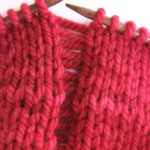Catch and Fix Mistakes
Table of Contents
Top Ten Reasons Why It’s Great to Mess Up
Preventing Common Errors
- Knitting Too Tight
- Casting On Too Tight
- Binding Off Too Tight
- Not Tensioning Yarn Correctly (Or At All)
- Not Pushing Your Needle-Tips Far Enough Through Your Stitches
- Scrunching Up Stitches on Right-Hand Needle
- Letting Stitches Lag On the Left-Hand Needle
- Accidentally Twisting Stitches When Purling
Take Out Your Knitting to Fix a Mistake
- Undoing Knitting Stitch by Stitch (Tinking)
- Removing Your Needle and Pulling Out One or More Rows of Stitches
- Put Your Stitches Back on the Needle Correctly
Common Mistakes and How to Fix Them
- Mistakes in Ribbing
- A Funny-Looking Stitch (Looks Like a Double-Loop)
- Getting Turned Around the Wrong Way After Putting Your Knitting Down
- Accidentally Slipped a Stitch (Ladder Across the Back)
Fixing Dropped Stitches
- Fixing a Dropped Knit Stitch
- Fixing a Dropped Purl Stitch Two Ways
- Fixing a Dropped Stitch on Garter Stitch
- Fixing a Dropped Stitch 10 Rows Down (No Problem!)
Repairing Knitwear
Introduction: Top Ten Reasons Why It’s Great to Mess Up
It’s great to mess up, and I always encourage my students to do so as much as possible, for one or more of the reasons below. This fun list is just meant to give you ten reasons to relax and try something new, and hopefully, you’ll mess up! Counting down from #10…
#10 Pain Fades With Practice
You need to get used to the feeling of messing up. The more you do it, the less painful it becomes. What was once a heart-stopping tragedy become just another mistake, just something that needs to be fixed, or not, as you see fit.
#9 You Gain Self-Awareness
Usually, when you make a mistake, you learn that you didn’t know how to do something that you thought you did. This gives you the opportunity to refine your knitting.
#8 You Become More Helpful
It’s so nice to be able to help a friend when she makes the same mistake you did. You can now reassure her that it’s great to mess up, oh, and here’s how to fix that.
#7 You’re More Fun
In a knitting group, or a class, you become more fun to be around in when you are okay with making mistakes. It helps everyone relax and enjoy themselves more. Sometimes people just need to be reminded that it’s not the end of the world.
#6 You Make Friends
You can quickly make friends with people in your knitting group by asking them for help when you get stuck. And with this goes the corollary #5…
#5 You Gain Resource-Awareness
The more you ask, the more you learn who you can and can’t go to for reliable knitting help. There will often be people delighted to help you – the gems are the ones who will show you where you went wrong and how to fix it yourself. This doesn’t apply to just people, either. Knitting resources of all kinds – books, videos, and websites, need to be explored so you can find what kind of help works for you.
#4 You Make Better Choices
When you mess up, you learn what knitting situations are challenging for you, and you learn to avoid them in the future. A good example of this is finding out that it’s a bad idea to start a new lace project at knit- night. Painful yes, but a worthwhile lesson, and one better learned sooner rather than right before Christmas.
#3 You Taste Enlightenment
Sometimes you get to practice the ancient Buddhist art of non-attachment – of letting go – that comes with an entire project that is ruined. This skill serves us well in life, as the things we love change and go away, or get lost, stolen, or broken. The knowledge that we loved the thing while it was ours but that we are powerful enough to let it go is one of the beautiful rewards that messing up terribly brings into our lives, if we are willing to experience it.
#2 You Become Fearless
When you become less afraid of messing up, you will boldly attempt new patterns and techniques. You’ll make things you never thought possible, because the fear of messing up won’t stop you trying.
#1 You Attain Superstardom
The #1 reason why it’s great to make mistakes is that eventually, through making and learning how to fix all the knitting mistakes in the universe, you learn all the ins and outs of knitting, and you become a Knitting Superstar!!
So we’ve established unequivocally that it’s great to make mistakes. But I would be leaving you high and try if I didn’t show you what to do next! Refer to the videos in the next section any time you get stuck, and I’ll help you through the most common knitting mistakes.
Catch and Fix Mistakes
This is a short course whose purpose it is to teach you how to catch and fix any knitting mistakes you wish.
Because fixing mistakes is so important to becoming a successful knitter, the “Become a Knitting Superstar” Library is filled with troubleshooting videos related to specific techniques and projects. However the techniques gathered here are especially important because they apply to so many kinds of situations and common problems you may face.
These are the most common mistakes I’ve seen my knitting students make that cause them to knit slower, work harder, and get confused more often.
Just read through and watch the videos to see if you are making your knitting experience slower than it should be – and what to do about it.
Accidentally Slipped a Stitch (Ladder Across the Back)
Binding Off/Casting On Too Tight
A too-tight bind-off or cast-on can, at best, make your project look a little funny. At worst, you won’t be able to put the garment on.
Socks with a too-tight cast on will not go on your feet, and this usually isn’t something that blocking can fix.
If you are running into this, you have two choices: you can 1) bind off or cast on using a bigger needle in your right hand, or 2) use two needles held together, as in this video.
Darn Socks/Fix Holes in Damaged Knitwear
Click here to read my blog post about repairing knitwear.
Fix A Funny-Looking Stitch (Looks Like a Double-Loop)
Sometimes, you may find a funny-looking double-stitch where there should be just one. It may be because your loop of yarn didn’t get pulled all the way through your stitch. Here’s how to tell.
Fixing a Dropped Knit Stitch
A dropped knit stitch is very common. Here’s how to recognize it, and two ways to fix it.
Fixing a Dropped Purl Stitch Two Ways
Luckily, a dropped purl stitch is just a dropped knit stitch viewed from the other side. Again, here are two ways to fix it.
Fixing a Dropped Stitch on Garter Stitch
Fixing a Dropped Stitch 10 Rows Down (No Problem!)
Getting Turned Around the Wrong Way After Putting Your Knitting Down
Sometimes you’ve got to stop knitting in the middle of a row. But when you come back to your knitting, how do you know which direction to go in? And how do you know if you’ve gone the wrong way? Watch and learn.
Knitting Too Tight
Problem: Knitting too tight is a common habit for new knitters, but this habit becomes more and more ingrained the longer we knit. Many knitters come up with”workarounds” to adjust for the fact that they knit really tightly, but going up a needle size doesn’t do anything for the sore hands and tense shoulders that result from forcing your needle into too-tight stitches, and it doesn’t help the fact that is takes longer to knit tightly.
Fix: Stop this habit before it becomes permanent! Watch the video and learn how to tension the yarn so that it feeds correctly, and how to adjust your stitches as you knit so they are just right.
Letting Stitches Lag On the Left-Hand Needle
Problem: Not advancing the stitches on your left-hand needle makes you work harder and harder to get into those stitches. Yet many people do it, because they are afraid their stitches will pop off if they get too close to the edge.
Fix: Get in the habit of pushing the stitches up onto the tip of your left-hand needle as you knit. Also see my video on Using Your Fingers to Help You to solve this problem.
Mistakes in Ribbing
Knitting where you should purl and purling where you should knit makes a really obvious-looking mistake in ribbing. Learning to recognize knit and purl stitches can help you fix this problem.
Also, forgetting to move your yarn to the front or back when ribbing American-style can result in some funny criss-crossing over your needle. Here’s how to fix both problems.
Not Pushing Your Needle-Tips Far Enough Through Your Stitches
Problem: I see so many knitters doing this – they just barely push the tips of their needles through the stitches, and as a consequence, have to go really slowly and carefully to make sure that the stitches don’t fall off.
Fix: Easy! Push your needles all the way into your stitches, like I show in the video. Pair this fix with my video on Using Your Fingers To Help You and you should be golden.
Not Tensioning Yarn Correctly (Or At All)
Problem: I see about one in five American-style knitters using this technique. If you do this, you might be in the habit of pinching the yarn between your right forefinger and thumb, which forces you to let go of the right needle every time you go to wrap the yarn, and to let go of the yarn every time you need your fingers to adjust the needle. It can also give you a finger cramp.
Fix: Try tensioning the yarn as shown in the video, or wrap the yarn around the palm and/or little fingers to hold it taut while letting the yarn”feed” with every stitch.
Having the yarn go from the needle over the first joint of the pointer finger can take some getting used to, but, with practice, can speed up and even out your knitting tremendously.
Put Your Stitches Back on the Needle Correctly
Taking out stitches to undo a mistake is great. But what if you put them back on your needle facing the wrong way?
Here I show you the right way to put stitches back on your needle, and also that it really doesn’t matter – here’s a fast way to turn them around if you’ve got them wrong.
Removing Your Needle and Pulling Out One or More Rows of Stitches
Scrunching Up Stitches on Right-Hand Needle
Problem: If you do this, you may notice 10-20 new stitches stacking up on the tip of your right-hand needle, in front of your fingers. This can slow you down, as your fingers are nowhere near the tips of your needles, helping you knit. Knitters who do this also tend to slow down for fear of losing stitches off the tips of the needles.
Fix: Every time you notice this happening, simply move your right hand up the needle, massaging your new stitches evenly down along the length of the needle, and place your fingers over the stitches.
Twisting Stitches When Purling
Twisted stitches usually happen when you wrap the yarn the wrong way around your needle when you are purling. I show you how to do it the right way, both American and Continental style.






![[KnitFreedom] - How To Darn Socks And Mend Holes In Knitting](https://i.ytimg.com/vi/SXD3TdbpDbM/hqdefault.jpg)


![[KnitFreedom] Fixing a Dropped Purl Stitch](https://i.ytimg.com/vi/n2FFXM2dbnc/hqdefault.jpg)

![[KnitFreedom] Picking Up Dropped Knit Stitches 10 Rows Down](https://i.ytimg.com/vi/9rQ1lm49I6Q/hqdefault.jpg)











